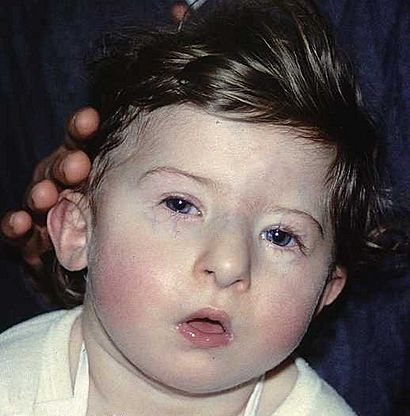DiGeorge syndrome facts for kids
Quick facts for kids DiGeorge syndrome |
|
|---|---|
| Synonyms | DiGeorge anomaly, velocardiofacial syndrome (VCFS), Shprintzen syndrome, conotruncal anomaly face syndrome (CTAF), Takao syndrome, Sedlackova syndrome, Cayler cardiofacial syndrome, CATCH22, 22q11.2 deletion syndrome |
 |
|
| A child with DiGeorge syndrome | |
| Symptoms | Variable; commonly congenital heart problems, specific facial features, cleft palate |
| Complications | Kidney problems, hearing loss, autoimmune disorders |
| Causes | Genetic (typically new mutation) |
| Diagnostic method | Based on symptoms and genetic testing |
| Similar conditions | Smith-Lemli-Opitz syndrome, Alagille syndrome, VACTERL, Oculo-auriculo-vertebral spectrum |
| Treatment | Involves many healthcare specialties |
| Prognosis | Depends on the specific symptoms |
| Frequency | 1 in 4,000 |
DiGeorge syndrome, also known as 22q11.2 deletion syndrome, is a syndrome caused by the deletion of a small segment of chromosome 22. While the symptoms can be variable, they often include congenital heart problems, specific facial features, frequent infections, developmental delay, learning problems and cleft palate. Associated conditions include kidney problems, hearing loss and autoimmune disorders such as rheumatoid arthritis or Graves disease.
DiGeorge syndrome is typically due to the deletion of 30 to 40 genes in the middle of chromosome 22 at a location known as 22q11.2. About 90% of cases occur due to a new mutation during early development, while 10% are inherited from a person's parents. It is autosomal dominant, meaning that only one affected chromosome is needed for the condition to occur. Diagnosis is suspected based on the symptoms and confirmed by genetic testing.
Although there is no cure, treatment can improve symptoms. This often includes a multidisciplinary approach with efforts to improve the function of the potentially many organ systems involved. Long-term outcomes depend on the symptoms present and the severity of the heart and immune system problems. With treatment, life expectancy may be normal.
DiGeorge syndrome occurs in about 1 in 4,000 people. The syndrome was first described in 1968 by American physician Angelo DiGeorge. In late 1981, the underlying genetics were determined.
| Classification |
[[d:Script error: The function "pageId" does not exist. |D]]
|
|---|---|
| External resources |
|
Images for kids
See also
 In Spanish: Síndrome de DiGeorge para niños
In Spanish: Síndrome de DiGeorge para niños


